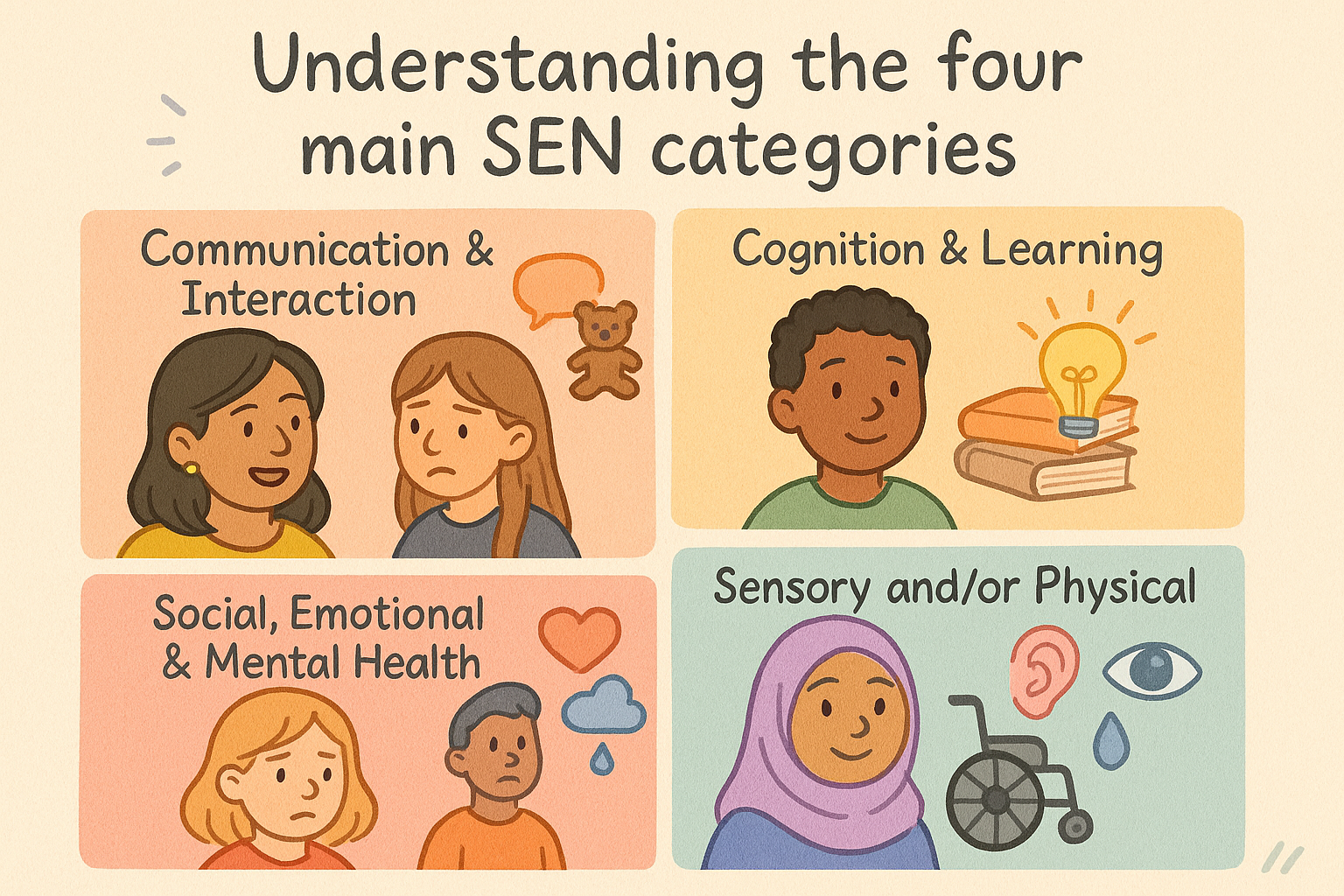If your child has additional needs, it helps to start with the way schools and local services usually describe them. In England (and in many local education settings), children’s special educational needs (SEN) are grouped into four broad areas of need. These are not neat boxes; many children will have needs across more than one area, but the framework is how schools plan support, write SEN records and (if needed) put together Education, Health and Care (EHC) plans.
Below, I explain each area in plain language, give common sub-categories or examples you might hear, and offer brief, practical pointers for parents when talking to school staff.
1) Communication & interaction
What it means: Difficulties with understanding or using language, or with social communication (how someone uses language and interacts with others). This area includes children who find it hard to follow instructions, join conversations, make friends, or use language in the usual way.
Common sub-categories/examples
- Speech, Language and Communication Needs (SLCN) — trouble saying sounds clearly, building sentences, or understanding what others say.
- Developmental Language Disorder (DLD) — persistent difficulty understanding and using language that isn’t explained by hearing loss or general learning disability.
- Autism Spectrum Condition (ASC / ASD) — affects social communication and interaction and commonly involves differences in social behaviour and flexibility; sensory differences are also common. (Autism is a broad profile — every child is different.)
- Selective mutism / pragmatic communication difficulties — being able to speak in some places (home) but not at school, or struggling with the ‘rules’ of conversation.
Practical pointers for parents
- Ask the school whether a speech and language therapist (SALT) has been involved or if a referral is needed.
- Share everyday examples: when your child finds instructions confusing, or avoids group talk — concrete instances help staff plan reasonable adjustments.
- Useful support at school can include visual instructions, extra time to process language, small-group work and predictable routines.
2) Cognition & learning
What it means: Difficulties with learning, remembering and processing information. This area covers both specific difficulties (that affect one area of learning) and broader learning needs that affect many parts of the curriculum.
Common sub-categories/examples
- Specific learning difficulties (SpLD) — such as dyslexia (reading and spelling), dyscalculia (maths), and dysgraphia (writing). These affect particular skills but don’t indicate low intelligence.
- Developmental coordination disorder/dyspraxia (DCD) — affects movement, coordination and sometimes fine motor skills needed for writing.
- Moderate/severe learning difficulties (MLD / SLD) and profound & multiple learning difficulties (PMLD) — where learning is affected across many areas and additional care or specialist teaching is needed.
Practical pointers for parents
- If you suspect a SpLD, ask about school screening or specialist assessment (educational psychologists or specialist teachers do some assessments).
- Reasonable classroom strategies include multisensory teaching, chunking instructions, assistive technology (text-to-speech, overlays) and extra time in tests.
- Keep examples of your child’s work at home to show areas of strength and difficulty — this helps the teacher describe the pattern of need.
3) Social, emotional & mental health (SEMH)
What it means: Difficulties that affect emotional well-being, behaviour or the ability to manage feelings and relationships. This might show as anxiety, low mood, challenging behaviour, withdrawal, or trauma-related responses. Schools often use this area when emotional or mental health needs affect learning or attendance.
Common sub-categories/examples
- Anxiety, depression and other mental-health difficulties that interfere with school life.
- Attachment needs and trauma-related difficulties — for children whose early relationships or experiences make trusting or regulating emotions hard.
- Behaviour that challenges / conduct difficulties — sometimes behaviour is a sign of underlying emotional need rather than willful disobedience. (Note: ADHD is a neurodevelopmental condition frequently discussed alongside SEMH in schools because it affects behaviour and self-regulation.)
Practical pointers for parents
- Be honest with school about what you see at home (triggers, how long behaviours last, what helps). This helps form an accurate support plan.
- Ask about access to school-based mental-health support, counselling, or a pastoral mentor, and whether a graduated approach (assess, plan, do, review) is being used.
- Gentle, consistent routines at home and school, and small, achievable steps back into learning, often work better than big, sudden demands.
4) Sensory and/or physical needs
What it means: Difficulties with sight, hearing, sensory processing (how the body interprets touch, sound, movement) or physical disabilities that affect mobility, stamina or coordination. These needs can make the classroom environment or everyday tasks harder.
Common sub-categories/examples
- Visual impairment (VI) — partial sight or blindness requiring adapted materials or assistive tech.
- Hearing impairment (HI) — from mild hearing loss to deafness; may need hearing aids, seating near the teacher, or a communicator/BSL support.
- Multi-sensory impairment (MSI) — combined sight and hearing differences.
- Physical disability (PD) — mobility or medical needs that require adaptations to the building, timetable or equipment.
Practical pointers for parents
- Make sure the school knows about any clinical reports (audiology, ophthalmology, occupational therapy) — these reports usually recommend specific adjustments.
- Discuss access needs (seating, timing of lessons, equipment) and whether an accessibility plan or PEEP (Personal Emergency Evacuation Plan) is required.
A few final things that matter to parents
- Children can have needs across more than one area. The four-area model is a starting point; professionals should look at the whole child, not just one label.
- Support is about the adjustments, not just the label. Whether a child has a diagnosis or not, what matters in school is the reasonable adjustments and teaching approaches that help them access learning.
- If extra help is needed, an EHC plan can be requested. EHC plans set out education, health and care needs and the support the local authority must provide; your local council publishes a clear guide about how to ask for an assessment.
